Table of Contents
Make your living room wall pop with a stunning gallery wall. These displays are more than pretty pictures. They tell your story and bring life to empty spaces.
Creating a gallery wall is not just about picking pictures. It’s about showing off your style and memories. Whether you love photos, art, or design, a gallery wall can make your home look amazing.
This guide will teach you all about making a perfect gallery wall. You’ll learn how to pick art and arrange it. Soon, your blank walls will become stunning highlights.
Understanding the Concept of a Gallery Wall
Gallery walls are more than just pictures on a wall. They are a way to make your home look amazing. They mix artwork, photos, and special items to show off your style.
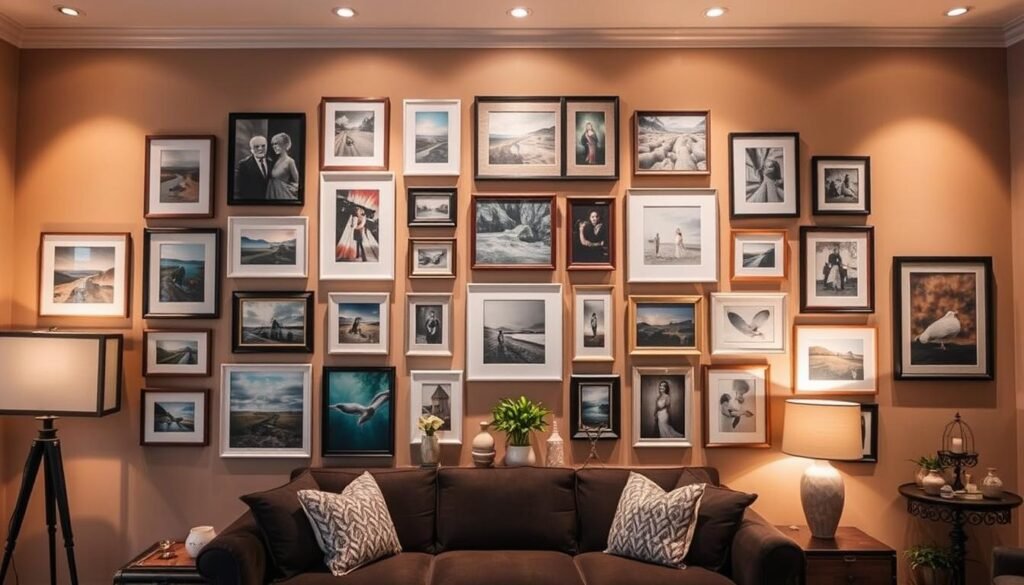
Looking into gallery wall ideas, you find a way to decorate that’s different. It lets you show who you are and use every inch of your walls.
Defining a Gallery Wall
A gallery wall is a group of framed pictures and items on one wall. It can include:
- Family photographs
- Vintage prints
- Contemporary art pieces
- Personal memorabilia
- Decorative objects
Benefits of a Gallery Wall
Gallery walls are great for many reasons:
| Benefit | Description |
|---|---|
| Personal Expression | Showcase unique style and memories |
| Visual Interest | Transform blank walls into compelling focal points |
| Flexibility | Easy to update and modify over time |
Key Elements to Consider
When making a gallery wall, think about these things:
- Color coordination
- Frame consistency
- Balanced composition
- Personal significance of artwork
Gallery walls invite creativity and personal storytelling through strategic visual arrangements. They are more than just decoration. They are a way to share your story and memories.
Choosing a Theme for Your Gallery Wall
Creating a gallery wall is like telling a story with pictures. It turns empty spaces into personal stories. Your gallery wall shows your style, memories, and what you like. Picking the right theme is key to making it look good and meaningful.
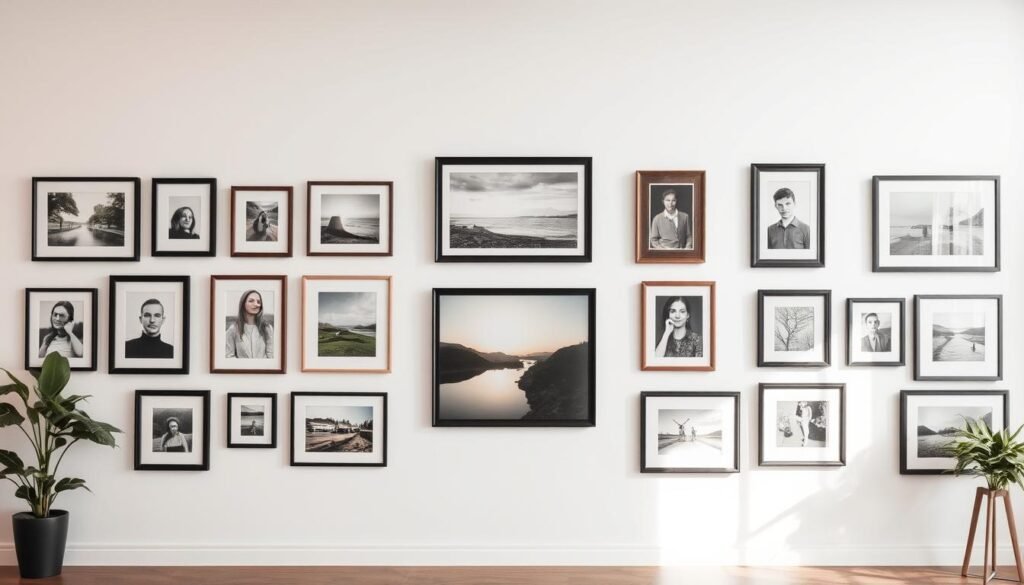
- What style you like and your home decor
- How you feel about the art
- The colors and how they look together
- The size of your wall
Art Styles and Genres
Your gallery wall can show different art styles that show who you are. You can have everything from simple prints to old photos. Here are some art styles you might like:
| Art Style | Characteristics | Best For |
|---|---|---|
| Contemporary | Bold colors, abstract designs | Modern living spaces |
| Classic | Traditional paintings, neutral tones | Elegant, timeless interiors |
| Eclectic | Mixed media, varied frames | Creative, personalized spaces |
Color Schemes and Cohesion
Color is very important in your gallery wall. Harmonious color palettes make your wall look good. Choose art that has colors that go well together.
Personal Touches and Memories
The best gallery walls tell your story. Add personal photos, travel items, or family treasures. These make your wall special and show your life’s journey.
Selecting the Right Artwork and Frames
Creating a stunning gallery wall starts with choosing the right artwork and frames. Your picture frame arrangement can turn an ordinary wall into a captivating visual story. It shows your personal style and creativity.
When picking artwork for your gallery wall, think carefully. Mix different mediums that show your personality and match your space:
- Photography prints
- Original paintings
- Vintage posters
- Personal memorabilia
- Three-dimensional art pieces
Art Types That Work Best
Focus on pieces that grab your attention. Diverse sizes and styles make your arrangement more interesting. Mix professional art with personal photos for depth and meaning.
Frame Style Considerations
Frames are key to your gallery wall’s look. Think about these frame choices:
- Consistent color palette
- Varied frame widths
- Matching metallic finishes
- Eclectic mix of vintage and modern frames
Mixing and Matching Frames
Good picture frame arrangement balances consistency and variety. Pick a common thread—like color or material—while letting each piece stand out. Wooden frames or metallic frames with the same finish can tie things together.
Pro tip: Lay out your frames on the floor before hanging. This lets you try different layouts and find a harmonious display.
Planning Your Layout
Creating the perfect gallery wall layout needs careful planning and creativity. Your picture frame arrangement can turn an ordinary wall into a stunning visual masterpiece. It shows your personal style and artistic vision.
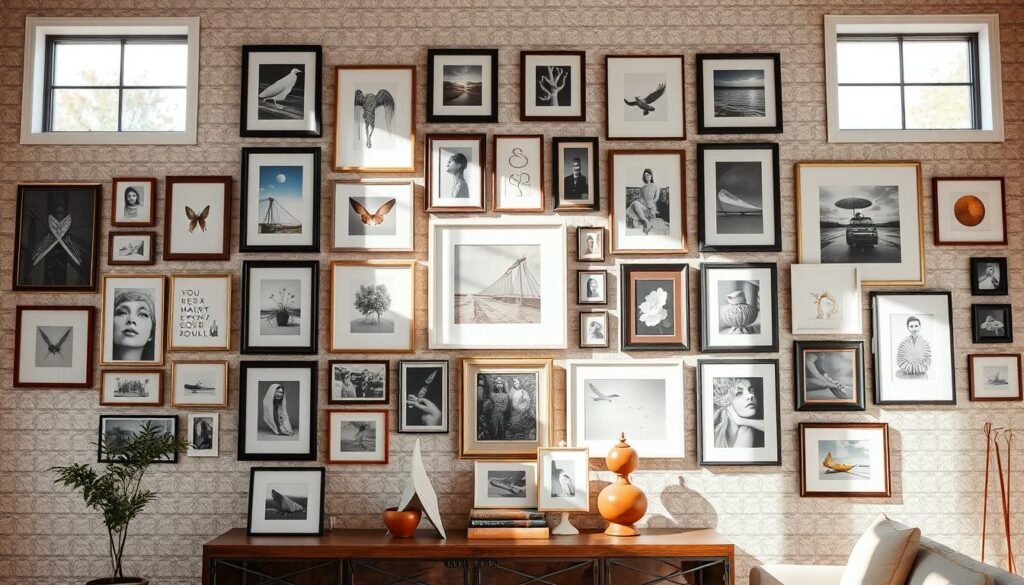
Designing a gallery wall means thinking about grid and asymmetrical layouts. Each style brings its own look that can change how your space looks.
Grid vs. Asymmetrical Layouts
When looking at gallery wall layouts, you’ll see two main designs:
- Grid Layout: A precise, structured setup with even spacing
- Asymmetrical Layout: A free-flowing design with different frame sizes
Essential Planning Tools
For a great picture frame arrangement, you need the right tools:
- Kraft paper templates
- Digital layout apps
- Measuring tape
- Painter’s tape
Tips for Arranging Artwork
Master your gallery wall layout with these tips:
| Strategy | Description |
|---|---|
| Anchor Pieces | Start with larger frames as central focus points |
| Visual Balance | Distribute artwork weight evenly across the wall |
| Spacing | Maintain consistent 2-3 inch gaps between frames |
Remember, making the perfect gallery wall is an art that takes patience. Don’t be afraid to try different layouts until you find one that shows your style!
Tips for Hanging Artwork
Creating a stunning gallery wall needs more than creativity. It also needs precision and the right technique. Learning how to hang a gallery wall can make your space look amazing. It turns blank walls into personal art exhibitions.
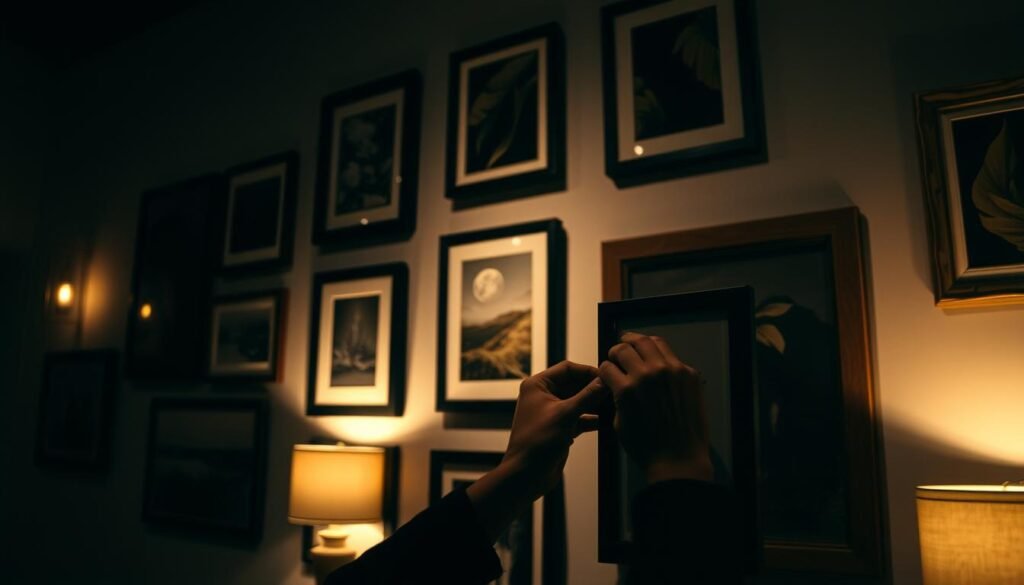
Hanging artwork is not just random. When you’re ready to learn, you’ll need a plan. This plan should mix artistic vision with technical skill.
Measuring with Precision
Accurate measurements are key for a gallery wall. Professional designers give these tips:
- Center artwork at eye level (typically 57-60 inches from the floor)
- Maintain consistent spacing between frames (2-3 inches is ideal)
- Use a laser level for perfectly straight alignments
Essential Tools for Success
Get these tools before you start hanging your gallery wall:
- Measuring tape
- Pencil for marking
- Stud finder
- Level
- Hammer or drill
- Appropriate wall anchors
Avoiding Common Hanging Mistakes
Even pros can make mistakes when hanging artwork. Pro tip: Always make a paper template of each frame. Test your layout before making holes in the wall. This trick can prevent wall repairs and frustration.
Remember, hanging a gallery wall is both science and art. Take your time, plan well, and adjust your design until it feels just right.
Refreshing Your Gallery Wall Over Time
Your living room wall decor is like a canvas that changes with you. It’s not just a static display. It’s a living piece of art that grows with your life.
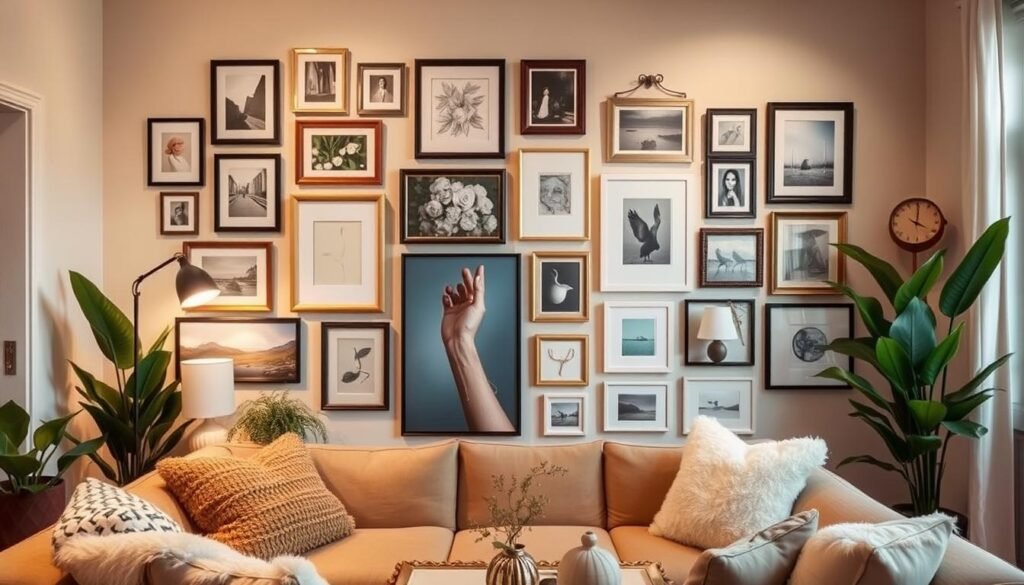
To keep your gallery wall alive, you need to be creative. Think of it as a project that changes with your style and memories.
Seasonal Transformations
Change your wall decor with the seasons. Here’s how:
- Put up warm, rich pieces in autumn
- Use coastal or nature art in summer
- Add holiday art in winter
Strategic Artwork Rotation
Rotating your art keeps your wall interesting. Pro tip: Store your extra art in protective sleeves or portfolios.
- Change your wall every 3-4 months
- Mix old and new art
- Have a special place for your art
Incorporating New Pieces
When you add new art, keep the balance. Choose pieces that fit with what you already have.
- Find art with similar colors
- Use different frame sizes and styles
- Place art in a way that looks good
Inspiration for Gallery Wall Ideas
Exploring gallery wall ideas can make your living room stand out. People are finding new ways to show off their style through art. It’s about telling your story through unique displays.
Design experts like Emily Henderson and Studio McGee are leading the way. They mix vintage and modern pieces in creative ways. Their work shows that gallery walls are more than pictures – they’re stories.